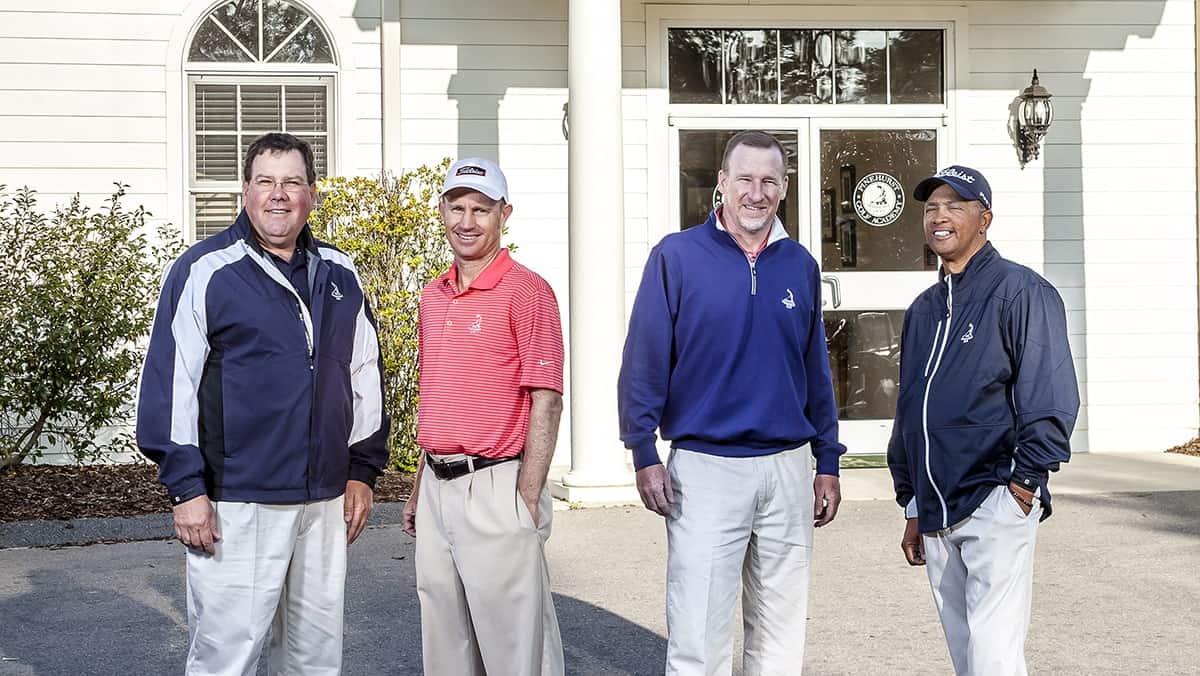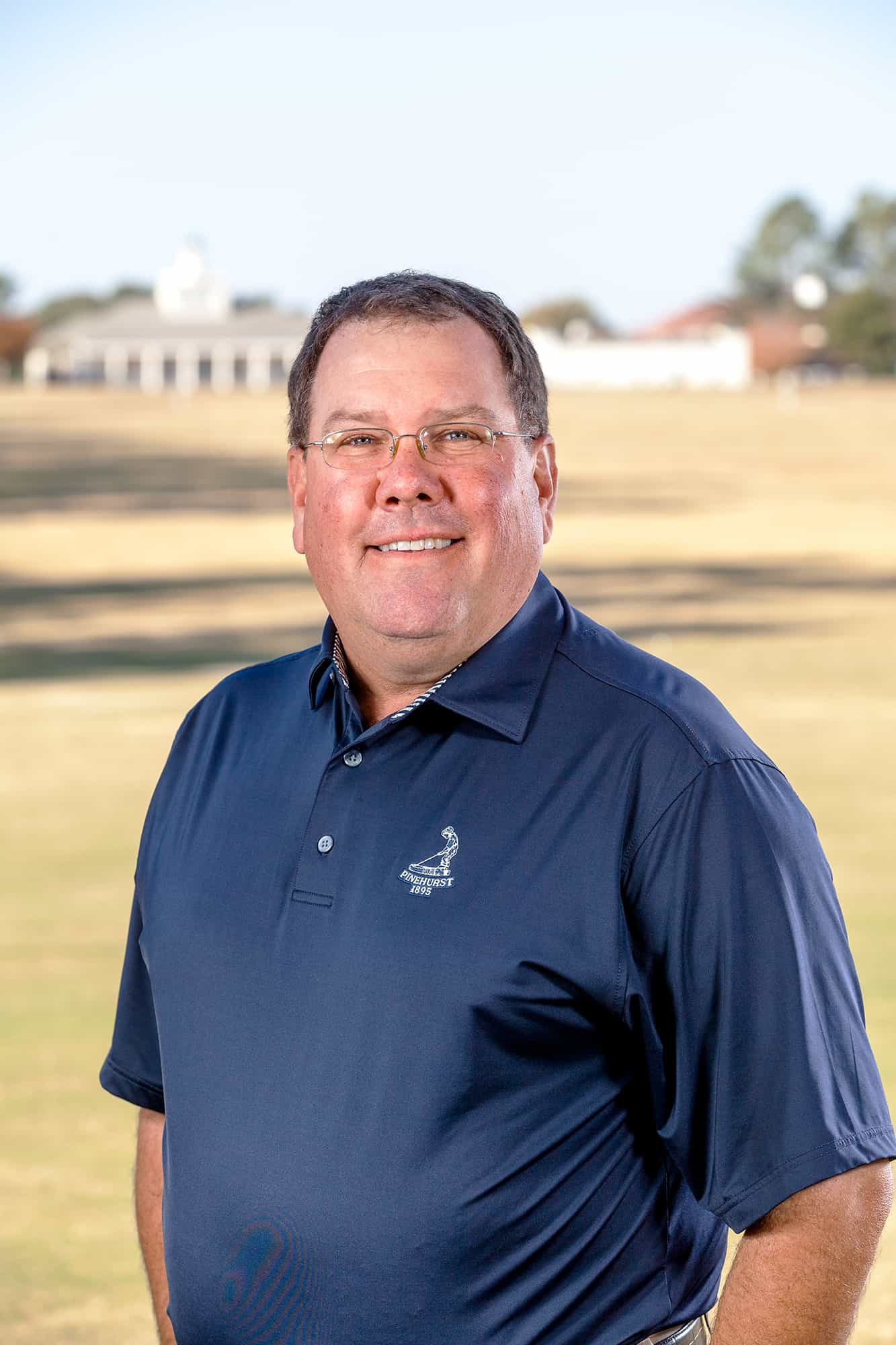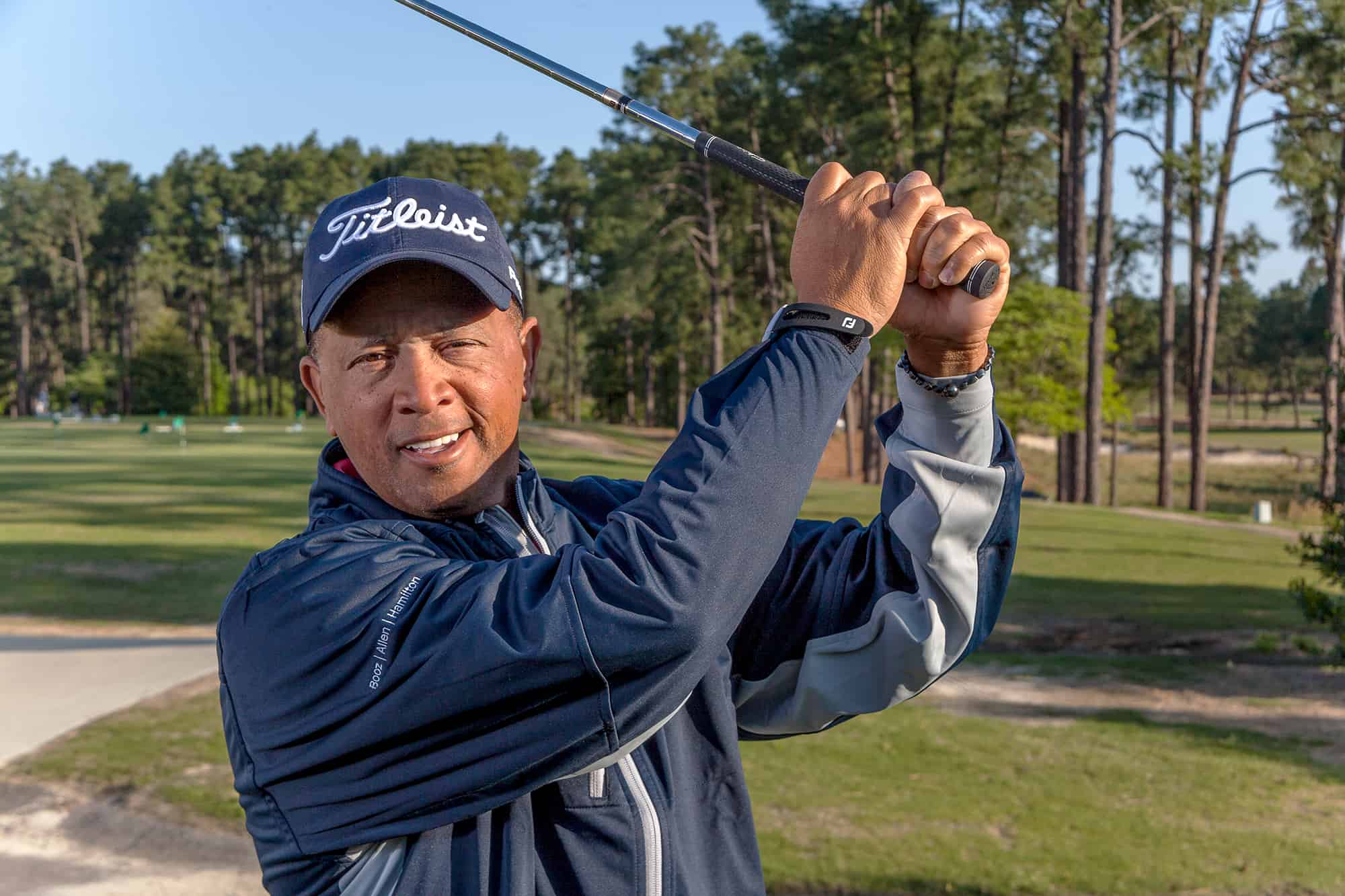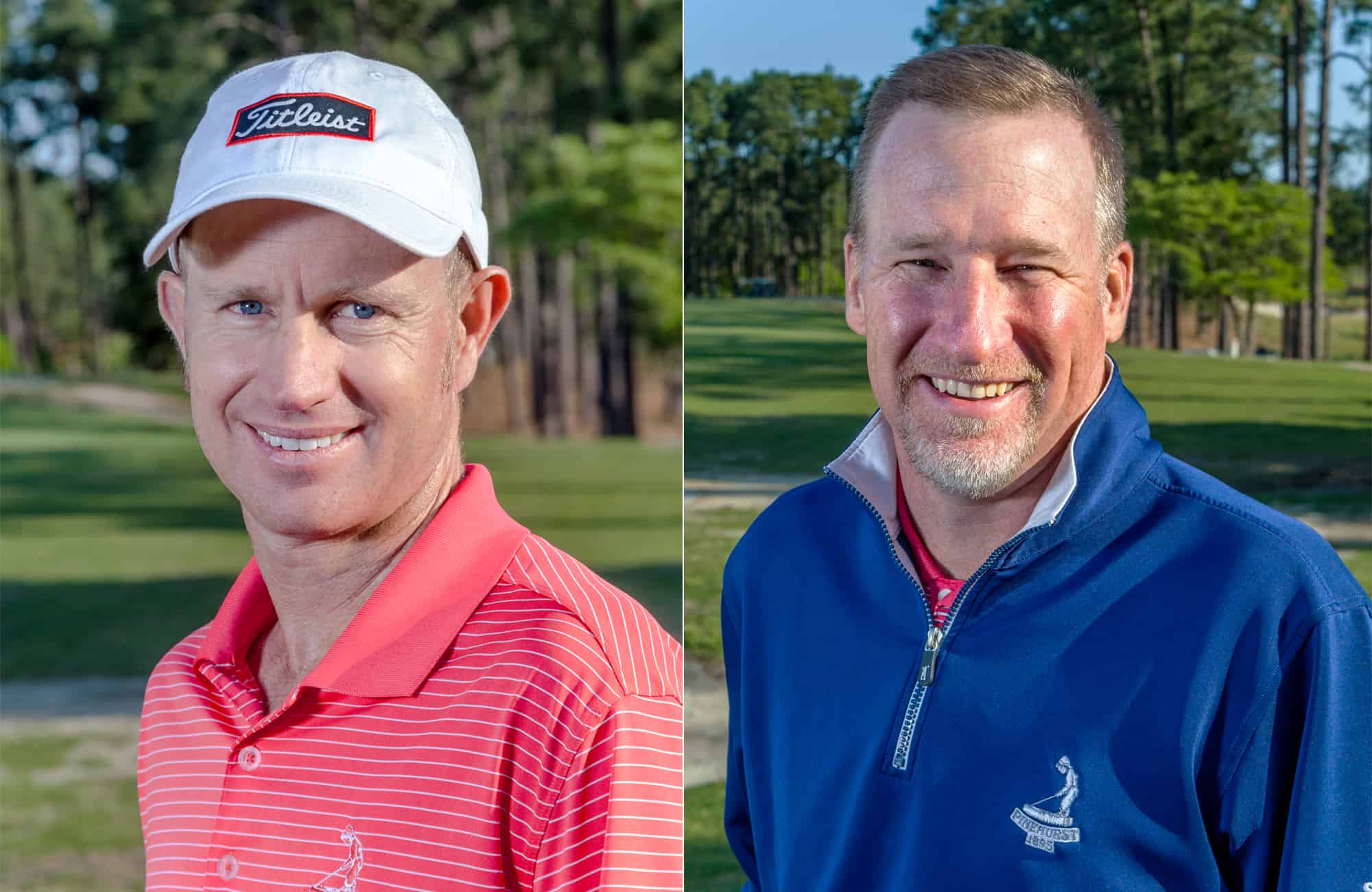
At the Pinehurst Golf Academy, students receive instruction from golf professionals who have called the range at Pinehurst home for several years: (from l-r) Eric Alpenfels, Kelly Mitchum, Geoff Lynch and Paul McRae.
Photos by John Gessner
BY LEE PACE
They have stood on the practice tee collectively for more than a century, through the winds of March and searing sun of July. They’ve seen laid-off club shafts, banana balls, weak grips, strong grips, hunched-over postures, flying elbows and lateral slides. The engineers who’ve come to them for help with their golf swing want a tip delivered on a slide rule, the artists prefer a catch phrase in rhyme.
LEARN MORE ABOUT THE PINEHURST GOLF ACADEMY
Their minds are like encyclopedias of golf instruction theory and drills. Their patience extends to the moon and back, their good humor worthy of an ice cream truck. Each has an amateur degree in psychology—how else to climb inside the brains of thousands of golfers over the years and figure out what makes them click?
Through it all, the Pinehurst Golf Academy staff of Eric Alpenfels, Paul McRae, Kelly Mitchum and Geoff Lynch have been Pinehurst’s Mount Rushmore—four instructors averaging 25 years on staff and giving the Academy the consistency and ballast to grow and thrive in a golf economy that’s weathered three recessions since 1990 and seen the gradual slide of the golf school business since the 2008-09 financial crisis.
“Our school has continued to grow while golf schools in general are passé,” says Don Padgett II, the Pinehurst president and COO from 2004-2014. “Their experience, their consistent delivery, the personal attention—these guys are the model to buck the trend. We get a lot of repeat business. We’ve got guys who’ve been coming for 20 years.”
“I don’t think you can find four guys anywhere in the world with as much experience and with as much experience together as we have,” adds Lynch.

Eric Alpenfels
Alpenfels, the head instructor and a member of GOLF Magazine’s Top 100 Teachers in America, joined the staff in 1985, so he’s got three decades at Pinehurst. McRae has been on staff for 30 years. Lynch has been a staff pro and teacher at Pinehurst for 27 years, and Mitchum is the relative newcomer at 21 years. He occasionally takes time off to venture onto the PGA Tour, where he’s competed in four PGA Championships and 23 career Tour events.
For each, the bottom line and ultimate satisfaction is helping golfers. They have, in the words of the late Robert Dedman, the Pinehurst owner from 1984-2012, “a servant’s heart.”
“We’ve got two guys who got here Monday who’ve been swinging over-the-top for years,” Alpenfels said one Wednesday morning in early April. “Two days later, they’re making downswings dead on plane. That’s an exciting thing. Tomorrow, we’ll show them their video of what they looked like when they arrived and now what they look like after three days.”
“I enjoy trying to figure out different kinds of people,” McRae says. “I love seeing the smile on their face when they hit a good shot. Watching a high-handicap player when they get to consistently hitting good shots, that’s fun. They come to you hitting one of 10 good shots and then get to three of 10 and then five of 10. That’s rewarding, watching that reaction when they hit a decent shot.”
Mitchum is a native of nearby Southern Pines, was an All-American golfer at N.C. State University and won the 1991 ACC Championship and 1993 North & South Amateur.
“My satisfaction from teaching comes from seeing a beginner get the ball in the air for the first time or a scratch golfer win a tournament,” says Mitchum. “Knowing you played a small part in their success is gratifying—no matter what level of player they are.”
Lynch grew up in Wilmington, Del., and came to Pinehurst in 1991 as an intern in golf operations, and since then has worked as head pro at courses 6 and 8, as tournament manager and today teaches in the Golf Academy and runs the Padgett Learning Center and the resort’s golf equipment operation.
“I relate golf instruction to being a doctor,” he says. “People generally don’t come unless they want help, and they are usually pretty happy when they leave. You’ve helped them accomplish a goal.”

Paul McRae
The Golf Academy runs schools Monday through Thursday and on weekends Friday through Sunday from March through November. From three-to-four instructors will work each school, depending on enrollment, and each school includes video analysis and time spent on the full swing, chipping, pitching, sand play, putting and course management. At any given time, there might be a dozen students hitting balls and three instructors alternating their attention and expertise through the group. In the afternoon, the teachers join the students for nine holes of on-course instruction.
Because the instructors’ bedrock teaching philosophy and knowledge of one another have been bound by years of collaboration, the effect of the teaching group is bigger than the sum of its parts.
“We never worry about saying something that will confuse someone because it contradicts what one of the other guys said,” McRae says. “You’ll be working down the line and tell a student something, and they might say, ‘Geoff just said the same thing.’”
“We’ve been together so long, we’re very much on the same page,” Mitchum adds. “The students hear the same messages but maybe phrased a little differently. It works well.”
In recent years Alpenfels has led his team into research projects that no other golf resort or school has had the vision or resources to take on. The staff has used Academy students as well as resort guests and members to participate in studies that have measured questions ranging from whether golfers can better practice lag putting by looking at the hole during the stroke rather than the ball; the effectiveness of various drills for curing the slice; and whether aiming at a pinpoint target on full shots yields better results than fixating on a larger target.

Kelly Mitchum and Geoff Lynch
These data points combined with video shot of each student from multiple angles allow the instructors to offer proof in a variety of formats that what they are teaching works. The next challenge is to translate it to a message the golfer hears and understands.
“You have to create a relationship where they trust you and are willing to work hard to get there,” Alpenfels says. “Everything we do is research-based. It’s proven. Pretty quickly they figure out we know what we’re doing and they trust us.”
Each of the instructors is singing from the same hymnal but each has his own inflection and pitch. Between the group, someone will strike a chord with everyone who comes through the Pinehurst Golf Academy.
“You say something and see that it resonates, their face lights up, the light bulb goes on,” says Lynch. “It’s their, ‘Ah ha, oh gosh, I understand what you’re saying’ kind of moment. That’s what makes it worthwhile for us.”
Lee Pace is a regular contributor to the Pinehurst Blog. He latest book, “The Golden Age of Pinehurst—The Rebirth of No. 2,” is available in all retail shops at Pinehurst.

